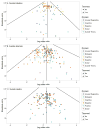Understanding suicide risk within the Research Domain Criteria (RDoC) framework: A meta-analytic review
- PMID: 29064611
- PMCID: PMC5760472
- DOI: 10.1002/da.22686
Understanding suicide risk within the Research Domain Criteria (RDoC) framework: A meta-analytic review
Abstract
Background: The field is in need of novel and transdiagnostic risk factors for suicide. The National Institute of Mental Health's Research Domain Criteria (RDoC) provides a framework that may help advance research on suicidal behavior.
Method: We conducted a meta-analytic review of existing prospective risk and protective factors for suicidal thoughts and behaviors (ideation, attempts, and deaths) that fall within one of the five RDoC domains or relate to a prominent suicide theory. Predictors were selected from a database of 4,082 prospective risk and protective factors for suicide outcomes.
Results: A total of 460 predictors met inclusion criteria for this meta-analytic review and most examined risk (vs. protective) factors for suicidal thoughts and behaviors. The overall effect of risk factors was statistically significant, but relatively small, in predicting suicide ideation (weighted mean odds ratio: wOR = 1.72; 95% CI: 1.59-1.87), suicide attempt (wOR = 1.66 [1.57-1.76), and suicide death (wOR = 1.41 [1.24-1.60]). Across all suicide outcomes, most risk factors related to the Negative Valence Systems domain, although effect sizes were of similar magnitude across RDoC domains.
Conclusions: This study demonstrated that the RDoC framework provides a novel and promising approach to suicide research; however, relatively few studies of suicidal behavior fit within this framework. Future studies must go beyond the "usual suspects" of suicide risk factors (e.g., mental disorders, sociodemographics) to understand the processes that combine to lead to this deadly outcome.
Keywords: Research Domain Criteria; meta-analysis; risk factor; suicide; suicide attempts.
© 2017 Wiley Periodicals, Inc.
Figures
Similar articles
-
Self-injurious thoughts and behaviors as risk factors for future suicide ideation, attempts, and death: a meta-analysis of longitudinal studies.Psychol Med. 2016 Jan;46(2):225-36. doi: 10.1017/S0033291715001804. Epub 2015 Sep 15. Psychol Med. 2016. PMID: 26370729 Free PMC article. Review.
-
Potential Applications of the National Institute of Mental Health's Research Domain Criteria (RDoC) to Clinical Psychiatric Practice: How RDoC Might Be Used in Assessment, Diagnostic Processes, Case Formulation, Treatment Planning, and Clinical Notes.J Clin Psychiatry. 2017 Apr;78(4):423-432. doi: 10.4088/JCP.15nr10476. J Clin Psychiatry. 2017. PMID: 28002661 Review.
-
A qualitative systematic review of suicide behavior using the cognitive systems domain of the research domain criteria (RDoC) framework.Psychiatry Res. 2019 Dec;282:112589. doi: 10.1016/j.psychres.2019.112589. Epub 2019 Nov 6. Psychiatry Res. 2019. PMID: 31703982
-
Understanding Suicide Risk within the Research Domain Criteria (RDoC) Framework: Insights, Challenges, and Future Research Considerations.Clin Psychol Sci. 2017 May;5(3):568-592. doi: 10.1177/2167702616686854. Epub 2017 Apr 26. Clin Psychol Sci. 2017. PMID: 28670505 Free PMC article.
-
Biological risk factors for suicidal behaviors: a meta-analysis.Transl Psychiatry. 2016 Sep 13;6(9):e887. doi: 10.1038/tp.2016.165. Transl Psychiatry. 2016. PMID: 27622931 Free PMC article.
Cited by
-
The FDA "Black Box" Warning on Antidepressant Suicide Risk in Young Adults: More Harm Than Benefits?Front Psychiatry. 2019 May 3;10:294. doi: 10.3389/fpsyt.2019.00294. eCollection 2019. Front Psychiatry. 2019. PMID: 31130881 Free PMC article.
-
Immersive and reflective recall of a suicidal episode: Implications for assessing and treating suicidal adolescents.J Consult Clin Psychol. 2023 Sep;91(9):533-546. doi: 10.1037/ccp0000829. Epub 2023 Jun 1. J Consult Clin Psychol. 2023. PMID: 37261740 Free PMC article. Clinical Trial.
-
Theta oscillatory dynamics serving cognitive control index psychosocial distress in youth.Neurobiol Stress. 2023 Dec 15;29:100599. doi: 10.1016/j.ynstr.2023.100599. eCollection 2024 Mar. Neurobiol Stress. 2023. PMID: 38213830 Free PMC article.
-
Neural responsiveness to reward and suicidal ideation in social anxiety and major depression before and after psychotherapy.Biol Psychol. 2023 Mar;178:108520. doi: 10.1016/j.biopsycho.2023.108520. Epub 2023 Feb 17. Biol Psychol. 2023. PMID: 36801433 Free PMC article. Clinical Trial.
-
Looking to the Future: A Synthesis of New Developments and Challenges in Suicide Research and Prevention.Front Psychol. 2018 Nov 27;9:2139. doi: 10.3389/fpsyg.2018.02139. eCollection 2018. Front Psychol. 2018. PMID: 30538647 Free PMC article.
References
-
- Abramson LY, Alloy LB, Hogan ME, Whitehouse WG, Gibb BE, Hankin BL, Cornette MM. Suicide Science. Springer US; 2002. The hopelessness theory of suicidality; pp. 17–32.
-
- Barak-Corren Y, Castro VM, Javitt S, Hoffnagle AG, Dai Y, Perlis RH, … Reis BY. Predicting suicidal behavior from longitudinal electronic health records. American Journal of Psychiatry 2016 - PubMed
Publication types
MeSH terms
Grants and funding
LinkOut - more resources
Full Text Sources
Other Literature Sources
Medical
Miscellaneous



